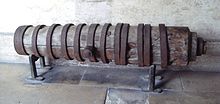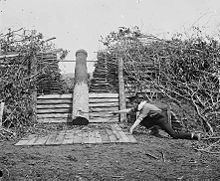- Wooden cannon
-
 Vietnamese wooden cannon captured at the Vinh Long citadel by the French on 23 March 1862. Caliber: 97 mm. Length: 1.90 m. Musée de l'Armée, Paris
Vietnamese wooden cannon captured at the Vinh Long citadel by the French on 23 March 1862. Caliber: 97 mm. Length: 1.90 m. Musée de l'Armée, Paris
 Muzzle of Vietnamese wooden cannon, 1862, Vĩnh Long
Muzzle of Vietnamese wooden cannon, 1862, Vĩnh Long
Wooden cannons are cannons made of wood, sometimes reinforced with straw or rope bindings or metal rings.
Contents
Expedient technique
The use of wood for cannon making could be dictated either by the lack of metal, or the lack of skill to engineer metallic cannons. Wooden cannons were notoriously weak, and could usually fire only a few shots, sometimes even just one shot, before bursting.[1] The balls for use in such wooden-barreled cannons could be made of various materials such as wood, stone, ceramics, or steel.
 Japanese coastal wooden cannon built by the Daimyos at the Bakufu's order for Commodore Perry's arrival. 1853-54
Japanese coastal wooden cannon built by the Daimyos at the Bakufu's order for Commodore Perry's arrival. 1853-54
Wooden cannons have been used at various times. Aurangzeb in the Deccan used such cannons for defensive purposes, as he lacked regular cannons but had abundant wood available.[1] Wooden cannons were used by the Vietnamese against the French during the Cochinchina campaign in 1862.[1] Some Japanese forces used wooden cannons during the Boshin war in 1868. The Native Peoples of South America used wooden cannons against the Spanish and Portuguese during the 17th and 18th centuries.[2] The Native Americans in North America used improvised wooden cannons against fortifications.[3] Squire Boone also constructed a wooden cannon used in the defense of Boonesborough, Kentucky in 1778 Siege of Boonesborough
Wooden cannons were used in Europe on various occasions. Russian Tsar Peter the Great is known to have built several as a childhood pastime.[4] Bulgarians used 52 cherry-wood cannon during the April Uprising in 1876. While the Macedonian bulgarians also produced cherry-wood cannons before the Ilinden Uprising in 1903.
Deception method
 Quaker Gun near Centreville, Virginia, USA, in March 1862, after the Confederate withdrawal
Quaker Gun near Centreville, Virginia, USA, in March 1862, after the Confederate withdrawal
In some conflicts, fake cannons made from a wooden log, sometimes painted black, were used to deceive an enemy. Misleading the enemy as to the strength of an emplacement was an effective delaying tactic. Both sides of the American Civil War used such faked weapons, called Quaker Guns. The name derives from the Religious Society of Friends or "Quakers", who have traditionally held a religious opposition to war and violence in the Peace Testimony.
Notes
- ^ a b c A History of Firearms by W. Y. Carman p.64 [1]
- ^ A Vanished Arcadia Being Some Account of the Jesuits in Paraguay 1607 to 1767 By R. B. Cunninghame Graham, p. 255 [2]
- ^ Stories of American Life and Adventure by Edward Eggleston p. 132 [3]
- ^ The Oxford Book of Military Anecdotes by Max Hastings p. 138 [4]
See also
Categories:- Artillery by type
- Cannon
Wikimedia Foundation. 2010.

